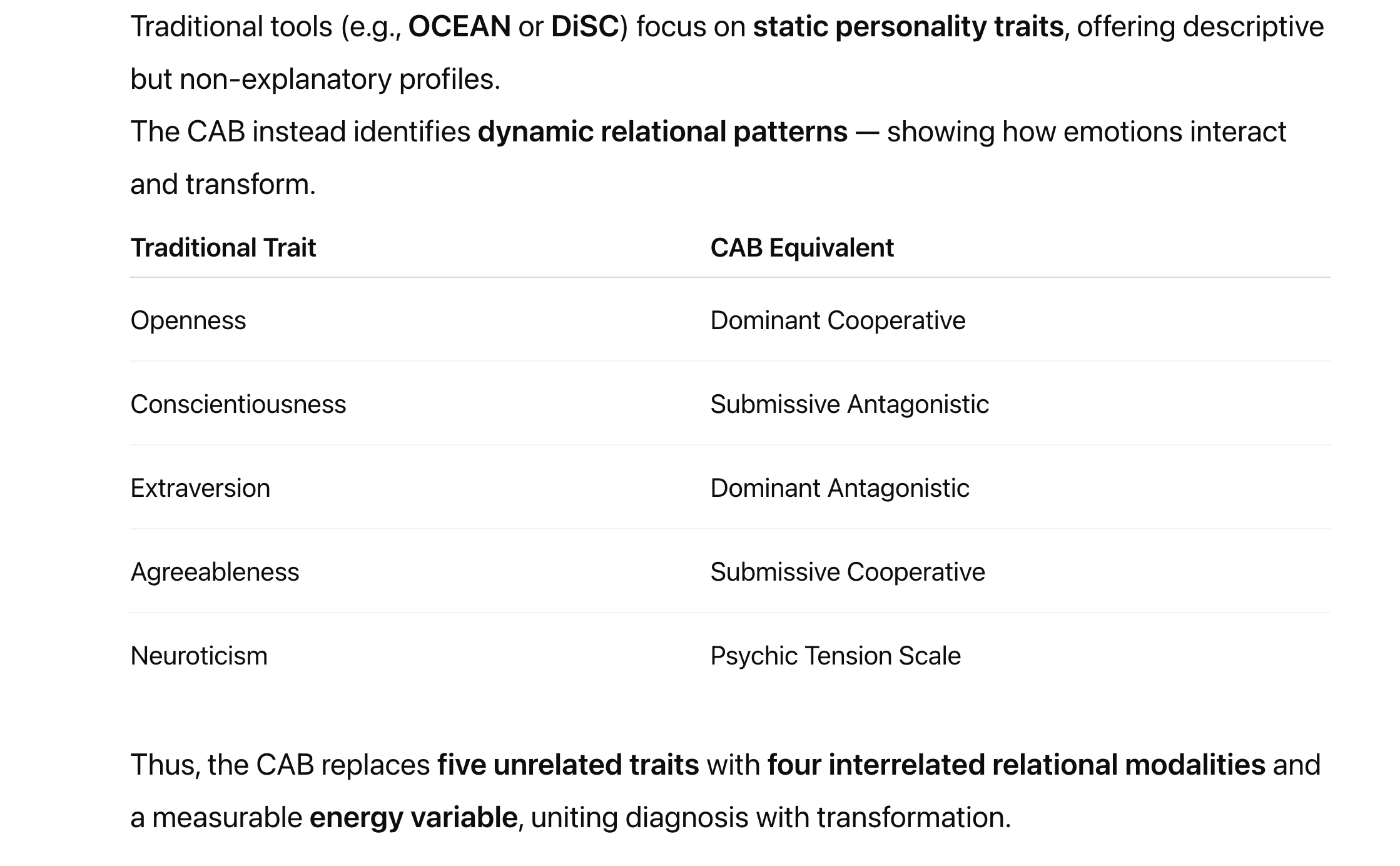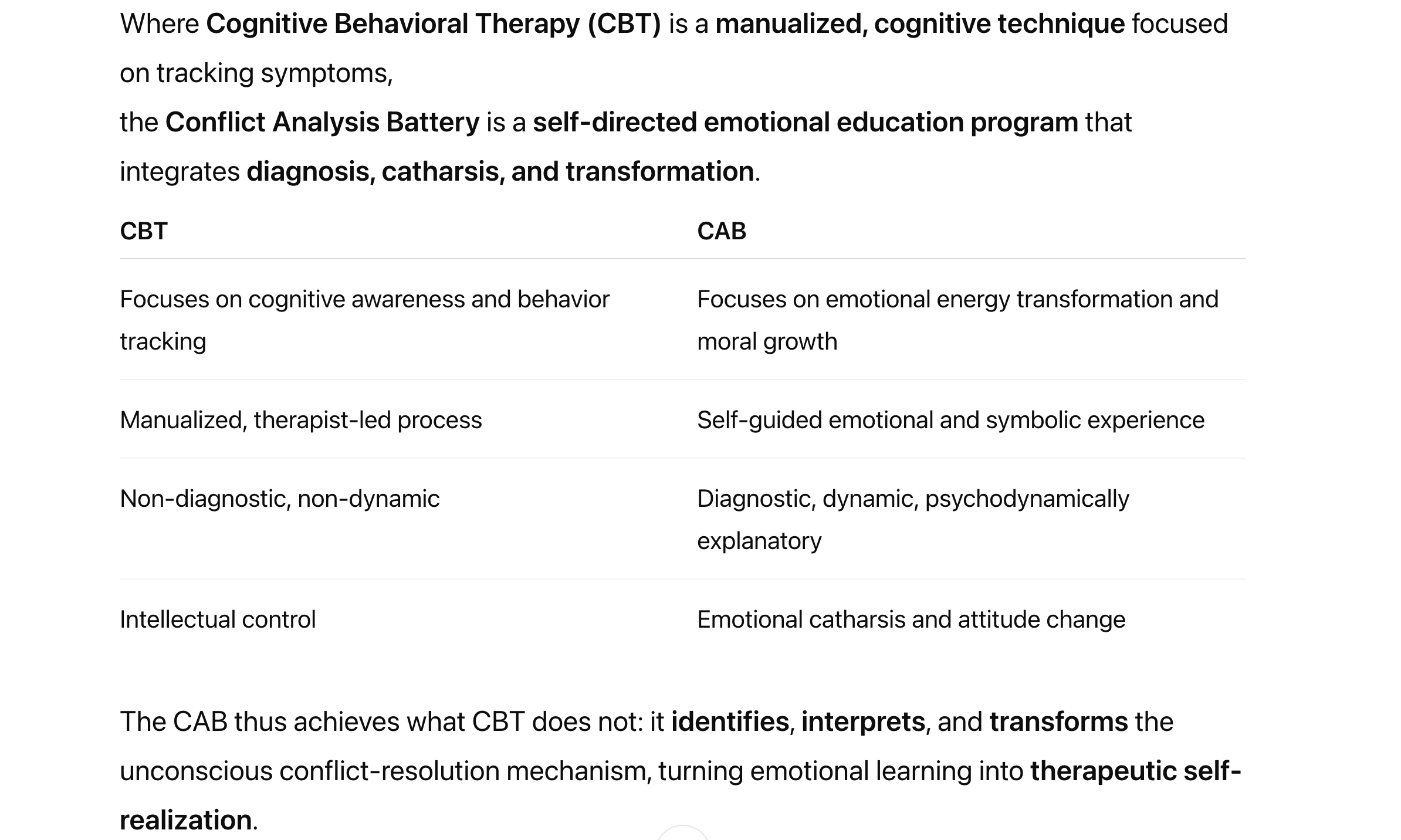Conflict Analysis Battery (CAB)
The Scientific Foundations: The Unconscious as a Measurable Mechanism
The Formal Theory conceptualizes the unconscious as a natural-science mechanism with a moral, conflict-resolution function.
It operates according to two observable physical phenomena:
Equilibrial Balance — represented by the trays of a scale, depicting emotional equilibrium.
Energetic Oscillation — represented by the pendulum’s swing, illustrating emotional energy seeking resolution.
These mechanical equivalents define the creative process as a measurable system with both formal (structural) and energetic (emotional) dimensions.
In this way, mental order becomes scientifically quantifiable—expressing itself as patterns of emotional transformation that mirror the laws of physics.
The Creative Process as the Unit of Behavioral Science
The object of study in the Formal Theory is the creative process itself—understood as a periodic conflict-resolution phenomenon.
This process reveals that the unconscious functions as an equilibrial system of interrelated emotions that naturally seek higher order and moral adjustment.
Emotions are thus real energetic entities, and their transformation through conflict represents the unit of order for all social sciences—a formal and energetic process leading toward resolution and wellbeing.
The Battery as an Emotional Education
The unconscious is a measurable scientific phenomenon. It is also a conflict resolution or moral order phenomenon. The Conflict Analysis Battery measures it as an emotional sequence that leads to four types of conflict resolution. Completing it is an emotional educational experience. The test taker generates by oneself insights. These are enhanced by AI automatic interpretation of the battery report.
The Conflict Analysis Battery (CAB; Levis, 1988) represents a major innovation in psychological assessment. It examines the two components of the unconscious: an emotional pattern and a relational modality, one’s personality type. It is grounded in the Formal Theory of Behavior connecting emotions and behaviors into a pattern of conflict resolution identifying the unconscious as a measurable, meaningful entity. The study of the creative process empowers individuals to understand psychology as both a science but also as compelling conflict resolution, that is moral order.
The battery may be used for educational, and for clinical purposes. It is meaningful to the test taker without requiring professional services. It is an interactive learning program unlike any other psychological test. It is didactic, diagnostic, and therapeutic—valid and reliable, humanistic and meaningful. Completing it is both an intellectual and emotional experience, It represents by itself a concise, personalized program of emotional education. A Theory-Based Self-Assessment
Unlike traditional instruments that only measure surface traits, the CAB is theory-based.
It combines:
a structured inventory that identifies one’s relational modality, and
projective creative tasks that reveal the six-role emotional sequence underlying personal conflict resolution.
Through these exercises, the CAB allows individuals to become conscious of their unconscious, gaining insight into their own emotional transformations.
This self-discovery process makes the CAB simultaneously educational, diagnostic, and therapeutic.
The CAB Experience
The Battery is introduced by an educational essay. It consists of a personality inventory and a number of creativity generating tasks.
The inventory identifies one’s relational modality diagnosis. It measures the intensity of psychic tension.
The projective metaphor creation tasks evoking insights are therapeutic. Each creativity test captures the individual’s emotional pattern reflecting one’s relational style. It evokes cathartic emotional release, guiding toward attitude change healing.
By combining intellectual understanding, emotional expression, and behavioral insight, the CAB becomes a powerful tool for emotional education and personal growth.
Beyond Traditional Personality Tests
Most modern assessments—such as the Big Five (OCEAN) or DiSC—measure traits as isolated factors.
While useful, these approaches are descriptive, not explanatory.
They lack the psychodynamic or therapeutic value that connects emotional energy, conflict, and resolution.
In contrast, the CAB:
Identifies relational patterns, not isolated traits
Measures emotional energy and balance
Guides moral and behavioral transformation
The CAB’s inventory organizes personality into four relational modalities, derived from three formal dichotomies:
Passive ↔ Active
Cooperative ↔ Antagonistic
Alienation ↔ Mutual Respect
Together, these dichotomies define four formally interrelated conflict-resolution styles, corresponding to both diagnostic categories of wellness and psychic tension levels.
Structure of the Assessment
The CAB consists of two integrated parts:
Relational Modality Inventory — a structured diagnostic tool measuring patterns of emotional relating and intensity of internal conflict.
Ten Creative Tasks — projective exercises that reconstruct the six-role emotional sequence of stress, response, anxiety, defense, reversal, and compromise.
Together, they reveal the emotional chain reaction of the unconscious—the measurable creative process through which human beings resolve conflicts and achieve growth.
Conclusion
The Conflict Analysis Battery transforms psychological testing into an emotional education experience.
It introduces a scientific model of the unconscious as a self-adjusting, moral mechanism, allowing individuals to diagnose, understand, and resolve their own conflicts.
Traditional psychology describes personality pathologies. The CAB explains personality types as wellness categories that are meaningful for the person.
The self-assessment battery is not just a test—it is a learning experience about psychology helping a person to understand oneself, one’s way of dealing with stress.
Features of the Conflict Analysis Battery (CAB)
A Radical Breakthrough in Psychological Assessments
The Conflict Analysis Battery (CAB) represents a major advance in psychological and educational technology.
It redefines assessment as an interactive emotional education experience — uniting diagnosis, self-discovery, and therapeutic transformation within a single framework.
Grounded in the Formal Theory of Behavior, the CAB measures the unconscious as a natural-science mechanism that resolves conflicts through measurable emotional processes.
1. Theory-Based Assessment that is interpreted by the person but also by AGI, Artificial General Intelligence.
The CAB is the first assessment grounded entirely in a scientific theory of the unconscious.
It measures the formal and physical dimensions of human conflict resolution — validating the Formal Theory’s premise that the unconscious follows a six-role emotional sequence guided by three formal operations (Reciprocity, Negation, Correlation).
2. A Comprehensive Battery
The CAB combines two complementary tests:
a Personality Inventory, which measures the three formal operations underlying relational behavior; and
a Projective Task Set, which identifies the six emotional roles of the creative process: stress, response, anxiety, defense, reversal, and compromise.
Together, these components measure both the structure and the energy of emotional functioning.
3. Cross-Validation Between Tests
Each test cross-validates the other.
The inventory defines abstract relational variables, while the projectives illustrate them concretely through metaphor creation.
This dual method identifies the test taker’s relational modality both conceptually and experientially, confirming diagnostic accuracy.
4. A Structured Self-Assessment
Participants actively construct and interpret their own metaphors through a guided questionnaire and visual template.
This process allows individuals to recognize their personal conflict resolution pattern, understand their relational modality, and explore ways to improve emotional adjustment.
5. Educational and Scientific Dimensions
The CAB demonstrates the scientific and moral organization of the unconscious.
It applies the principles of Simple Harmonic Motion (SHM) to emotional transformation — organizing the six emotional roles into a predictable pattern of equilibrium restoration.
Through this structure, participants witness the physics of emotion in action, illustrated in their own symbolic language and creative expression.
6. Diagnostic Precision: The Relational Modality Instrument
The personality inventory uses formal group transformations (derived from the Kleinian Group) rather than isolated traits.
These identify relational distinctions that are:
Reciprocal: Submissive vs. Dominant
Opposite: Cooperative vs. Antagonistic
Correlative: Alienation vs. Mutual Respect
This structure produces four diagnostic relational modalities, each linked to degrees of psychic tension, defining wellness versus pathology.
7. Therapeutic Impact Through Projective Experience
The projective portion of the CAB is therapeutic.
Participants experience emotions through metaphor construction, recognize their personal conflict patterns, and reformulate responses.
This process evokes catharsis and insight, allowing emotional reorganization and moral growth — transforming assessment into therapy.
8. Direct, Self-Generated Insight
All information is delivered directly to the test taker.
Through structured interpretation templates, participants can see their emotional drama visually represented — without requiring a professional intermediary.
Trained facilitators can support reflection, but the assessment itself is self-interpreting and empowering.
Each metaphor is analyzed through concentric sociograms showing power dynamics and cooperative versus antagonistic interactions.
9. Cost-Effective and Accessible
Because the CAB is self-administered and self-interpreting, it eliminates costly clinical interpretation.
The process itself generates emotional insight, measurable outcomes, and behavioral change — making it an efficient, affordable tool for individuals, schools, and organizations.
10. A Meaningful Clinical Record
The CAB produces a standardized, valid, and reliable clinical record that captures both intellectual and emotional dimensions.
It is valuable to clients, therapists, educators, and organizational consultants alike, offering a clear portrait of relational style, emotional health, and developmental trajectory.
11. Proven Validity and Reliability
Extensive statistical analyses confirm the CAB’s superior validity and reliability compared to conventional tests.
Its results consistently reproduce across populations, confirming its psychometric rigor and its scientific foundation in the Formal Theory.
The Online CAB Report
The online self-assessment automatically generates a comprehensive report combining all written, artistic, and reflective data into seven structured tables:
Relational Modality Evaluation Scale – Inventory results
Creativity Exercises Table – Six-role emotional sequence
Insight Table – Insights from creative tasks
Changes Table – Suggestions for behavioral modification
Self-Reflection Table – Evaluation of the learning experience
Query Table – Self-ratings of the didactic, diagnostic, and therapeutic impact
Transcription Table – Full record of responses and artwork
Together, these create a holistic emotional education profile.
Comparing the CAB with Traditional Assessments
Pattern Recognition vs. Trait Listing
Thus, the CAB replaces five unrelated traits with four interrelated relational modalities and a measurable energy variable, uniting diagnosis with transformation.
CAB vs. CBT: Diagnostic and Therapeutic Integration
An Example in Art: The Creator’s Personal Profile
Displayed at the Museum of the Creative Process, Dr. Albert Levis’s personal CAB sequence is depicted in the mural The Sanctuary of the Creative Process.
It portrays his transformation of trauma from the Holocaust into scientific and moral understanding — reconciling art and science, faith and reason.
The Judaic fiddler (symbolizing morality) stands upon the Grecian sanctuary (reason), surrounded by the flags of nations and religions — illustrating the resolution of conflict into universal harmony.
This artwork exemplifies how the CAB translates theory into both personal healing and cultural integration.


